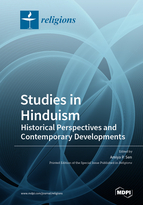Studies in Hinduism: Historical Perspectives and Contemporary Developments
A special issue of Religions (ISSN 2077-1444). This special issue belongs to the section "Religions and Humanities/Philosophies".
Deadline for manuscript submissions: closed (30 September 2020) | Viewed by 33149
Special Issue Editor
Interests: intellectual and cultural history of colonial India
Special Issues, Collections and Topics in MDPI journals
Special Issue Information
Dear Colleagues,
The inner structural complexities and the ideological heterogeneity of Hinduism never cease to amaze the interested scholar, an important reason, we feel, why it must be subjected to recurring scrutiny. In truth, such heterogeneities have also been instrumental in shaping the nature of older and quite persistent debates about whether Hinduism was indeed ‘discovered’ as claimed by scholars in the 1960s and 1970s or ‘invented’ as came to be increasingly accepted by an influential body of scholars subsequently. Looking back at such debates, one cannot resist the conclusion that important though as these have been, it is also time to outgrow the somewhat vacuous nature of these debates which appears to defy a consensual resolution. Much can be argued from either side. Thus, one may pertinently ask if it was indeed ‘Hinduism’ that was discovered by evangelists, merchants, soldiers, scholars, and bureaucrats in the age of the mercantile dominance and company rule. On the other hand, it is just as possible that conceptual continuities in time are somewhat obscured by the lack of a single descriptive word or term. Thus, in Hinduism, a reformist intent representing efforts to progressively change society or religion is considerably older than the accepted use of the term ‘reform’ and an accompanying discourse. Of the two points of view presented here, one presumes that Hindu society and religion gained momentum only with the entrenchment of British colonial rule, while the other projects contemporary developments to a remote historical past, simply for the sake of tendentiously establishing imagined continuities in time and space.
This Special Issue of Religions takes cognizance of such debates only tangentially; its overarching focus is on studying. more closely and critically, relatively unknown or under-researched facets of Hindu thought and socioreligious praxis. Alongside, there is also the attempt to revisit existing interpretations of texts, personalities or events inasmuch as they help us to overthrow simplistic presumptions about the complex nature of interpenetrations between the ‘secular’ and the ‘religious’. This is carried out within a hermeneutic framework that connects historical perspectives on Hinduism with contemporary developments. It is indeed our intention to more fully understand the dynamic interplay of locus and movement within the Hindu cultural and religious world; the dialogic nature of human language, ideas, imagination, intentions, and behavior which alone can bring us closer to an understanding of the actively relational aspects between that which appears at first glance to be only discrete subjects. We proceed on the premise that it is indeed difficult to fully understand a being either in nature or in human history by merely fixing it in its bare self identity. Social identities and subjectivities are perhaps best understood in relation to what appears as their very contradiction.
Contributors are encouraged to work on the following areas/themes:
- The transformative nature of human subjectivities;
- Transnational Hinduism;
- Pedagogic challenges to the teaching of Hinduism in the West;
- Representation and re-presentation of texts, events, figures;
- New media forms and Hinduism;
- Connecting the human and Divine in Hinduism.
This volume represents fresh thinking by a team of scholars, well established in their line of work. Further, contributors to this volume represent a variety of subdisciplines in the Humanities and Social Sciences: history, religious studies, philosophy, literature, and cultural anthropology. This has contributed substantially towards making this project instructively interdisciplinary in nature. The editor and his team of contributors see this particular volume as only one in a series of successive attempts at understanding the complexly structured world of Hinduism.
Prof. Dr. Amiya P. Sen
Guest Editor
Manuscript Submission Information
Manuscripts should be submitted online at www.mdpi.com by registering and logging in to this website. Once you are registered, click here to go to the submission form. Manuscripts can be submitted until the deadline. All submissions that pass pre-check are peer-reviewed. Accepted papers will be published continuously in the journal (as soon as accepted) and will be listed together on the special issue website. Research articles, review articles as well as short communications are invited. For planned papers, a title and short abstract (about 100 words) can be sent to the Editorial Office for announcement on this website.
Submitted manuscripts should not have been published previously, nor be under consideration for publication elsewhere (except conference proceedings papers). All manuscripts are thoroughly refereed through a double-blind peer-review process. A guide for authors and other relevant information for submission of manuscripts is available on the Instructions for Authors page. Religions is an international peer-reviewed open access monthly journal published by MDPI.
Please visit the Instructions for Authors page before submitting a manuscript. The Article Processing Charge (APC) for publication in this open access journal is 1800 CHF (Swiss Francs). Submitted papers should be well formatted and use good English. Authors may use MDPI's English editing service prior to publication or during author revisions.
Keywords
- hermeneutics
- secular
- historical perspectives
- contemporary developments
- complexity of structures
- subjectivities
- media
- transnational
- identities and oppositions
- pedagogic challenges






